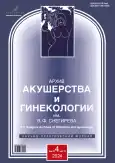细菌性阴道病不同表型变异的治疗策略
- 作者: Dobrokhotova Y.E.1, Kazantseva V.D.1, Ozolinya L.A.1, Savchenko T.N.1
-
隶属关系:
- Pirogov Russian National Research Medical University
- 期: 卷 11, 编号 4 (2024)
- 页面: 440-448
- 栏目: Original study articles
- URL: https://ogarev-online.ru/2313-8726/article/view/286423
- DOI: https://doi.org/10.17816/aog630065
- ID: 286423
如何引用文章
详细
背景。细菌性阴道病是女性下生殖道最常见的非炎症综合征,与产科和妇科实践中的严重并发症相关。目前,治疗细菌性阴道病的唯一方案是抗生素(甲硝唑和克林霉素),但这些药物通常只能提供短期效果。治疗结束后一年内,50~80%的病例会复发。这可能与阴道微生物群的特性有关,以及在抗生素治疗后有益的乳杆菌菌株(如 Lactobacillus crispatus)未能重新定植于阴道。由于缺乏有效的长期治疗方案,医生和科学家正在探索治疗和预防该综合征的多种方法,这也促进了对细菌性阴道病发病机制及患者管理方式的快速发展。目前针对细菌性阴道病治疗的研究领域包括抗菌剂、益生菌和益生元、阴道微生物群移植、pH调节及生物膜破坏。
研究目的。对细菌性阴道病治疗前后女性阴道乳杆菌(Lactobacillus spp.)及加德纳菌(Gardnerella vaginalis)基因型进行物种鉴定,比较单一抗菌治疗方案与结合含不少于10⁷个活乳酸杆菌(Lactobacillus acidophilus)的栓剂或乳酸与糖原组合的两阶段治疗方案的疗效。
材料与方法。开展了一项前瞻性、对照、随机研究,共招募90名年龄在18至45岁之间、通过分子遗传学方法诊断为细菌性阴道病的女性。参与者被随机分为三组,每组30人:第一组仅接受抗生素治疗,第二组接受抗生素治疗并使用含不少于10⁷个活乳酸杆菌的栓剂,第三组接受抗生素治疗并使用乳酸与糖原组合的治疗方案。在治疗结束后4周对治疗的临床和实验室效果进行了评估。
结果。所有三组在治疗结束4周后均在临床症状、阴道分泌物pH值及分子遗传学检测结果方面表现出积极变化,但第二组患者的效果更显著。
结论。抗生素联合乳酸与糖原的治疗方案具有较高的临床疗效和良好的耐受性,但需要进一步研究以评估长期疗效。
作者简介
Yulia E. Dobrokhotova
Pirogov Russian National Research Medical University
Email: pr.dobrohotova@mail.ru
ORCID iD: 0000-0002-7830-2290
SPIN 代码: 2925-9948
MD, Dr. Sci. (Medicine), Professor
俄罗斯联邦, MoscowValeriya D. Kazantseva
Pirogov Russian National Research Medical University
编辑信件的主要联系方式.
Email: shapee08@mail.ru
ORCID iD: 0000-0002-4011-3195
SPIN 代码: 6973-6276
Graduate Student
俄罗斯联邦, MoscowLyudmila A. Ozolinya
Pirogov Russian National Research Medical University
Email: ozolinya@yandex.ru
ORCID iD: 0000-0002-2353-123X
SPIN 代码: 9407-9014
MD, Dr. Sci. (Medicine), Professor
俄罗斯联邦, MoscowTatyana N. Savchenko
Pirogov Russian National Research Medical University
Email: 12111944t@mail.ru
ORCID iD: 0000-0001-7244-4944
SPIN 代码: 3157-3682
MD, Dr. Sci. (Medicine), Professor
俄罗斯联邦, Moscow参考
- Peebles K, Velloza J, Balkus JE, et al. High global burden and costs of bacterial vaginosis: a systematic review and meta-analysis. Sex Transm Dis. 2019;46(5):304–311. doi: 10.1097/OLQ.0000000000000972
- Turpin R, Tuddenham S, He X, et al. Bacterial vaginosis and behavioral factors associated with incident pelvic inflammatory disease in the longitudinal study of vaginal flora. J Infect Dis. 2021;224(12 Suppl 2):S137–S144. doi: 10.1093/infdis/jiab103
- Ivakhnishina NM, Ostrovskaya OV, Kozharskaya OV, et al. Intrauterine and postnatal infection agents detected in autopsy material of lost low-weight children. Far East Medical Journal. 2015;(4):44–47. EDN: VBKVXX
- Swidsinski S, Moll WM, Swidsinski A. Bacterial vaginosis-vaginal polymicrobial biofilms and dysbiosis. Dtsch Arztebl Int. 2023;120(20):347–354. doi: 10.3238/arztebl.m2023.0090
- Abou Chacra L, Fenollar F, Diop K. Bacterial vaginosis: what do we currently know? Front Cell Infect Microbiol. 2022;11:672429. doi: 10.3389/fcimb.2021.672429
- Vaneechoutte M, Guschin A, Van Simaey L, et al. Emended description of Gardnerella vaginalis and description of Gardnerella leopoldii sp. nov., Gardnerella piotii sp. nov. and Gardnerella swidsinskii sp. nov., with delineation of 13 genomic species within the genus Gardnerella. Int J Syst Evol Microbiol. 2019;69(3):679–687. doi: 10.1099/ijsem.0.003200
- Krysanova AA, Guschin AE, Savicheva AM. Significance of gardnerella vaginalis genotyping in diagnosis of recurrent bacterial vaginosis. Medical Alphabet. 2021;(30):48–52. EDN: WRBNOX doi: 10.33667/2078-5631-2021-30-48-52
- Swidsinski A, Mendling W, Loening-Baucke V, et al. Adherent biofilms in bacterial vaginosis. Obstet Gynecol. 2005;106(5 Pt 1):1013–1023. doi: 10.1097/01.AOG.0000183594.45524.d2
- Rumyantseva T, Golparian D, Nilsson CS, et al. Evaluation of the new AmpliSens multiplex real-time PCR assay for simultaneous detection of Neisseria gon- orrhoeae, Chlamydia trachomatis, Mycoplasma genitalium, and Tricho- monas vaginalis. APMIS. 2015;123(10):879–886. doi: 10.1111/apm.12430
- Bacterial vaginosis: clinical recommendations of the Russian Federation, 2022. (In Russ.)
- Clinical recommendations for the diagnosis and treatment of diseases accompanied by pathological secretions from the genital tract of women. Moscow, 2019. (In Russ.)
- Unemo M, Bradshaw CS, Hocking JS, et al. Sexually transmitted infections: challenges ahead. Lancet Infect Dis. 2017;17(8):e235–e279. doi: 10.1016/S1473-3099(17)30310-9
- Bilardi JE, Walker S, Temple-Smith M, et al. The burden of bacterial vaginosis: women’s experience of the physical, emotional, sexual and social impact of living with recurrent bacterial vaginosis. PLoS One. 2013;8(9):e74378. doi: 10.1371/journal.pone.0074378
- Dobrokhotova YuE, Bondarenko KR, Shadrova PA. The role of lactobacilli in restoring normal vaginal microbiota. Gynecology, Obstetrics and Perinatology. 2021;20(2):126–133. EDN: RUQZIZ doi: 10.20953/1726-1678-2021-2-126-132
- Dobrokhotova YuE, Shadrova PA. Novel treatment modalities for pelvic inflammatory disease using immunomodulating therapy. Russian Journal of Woman and Child Health. 2021;(4)2:149–154. EDN: EZRZCN doi: 10.32364/2618-8430-2021-4-2-149-154
- Savicheva AM, Shadrova PA. Potential use of lactic acid in obstetrics and gynecology. Russian Journal of Woman and Child Health. 2022;5(2):138–145. EDN: CEUJIM doi: 10.32364/2618-8430-2022-5-2-138-145
补充文件










